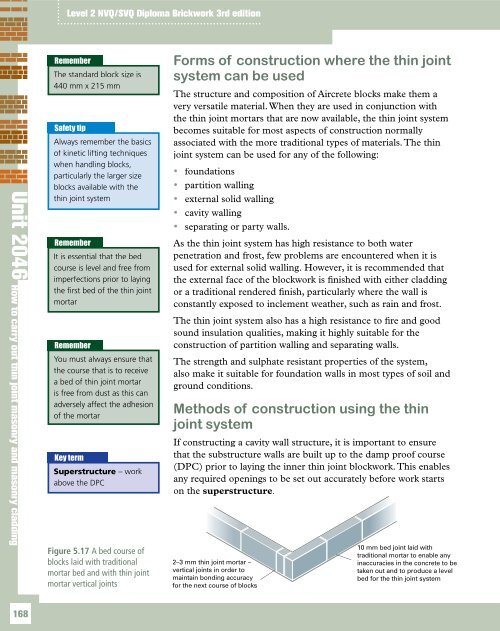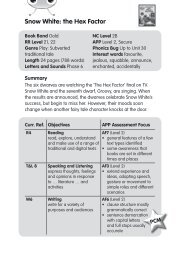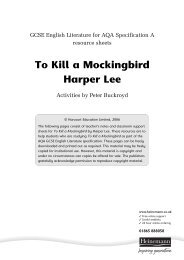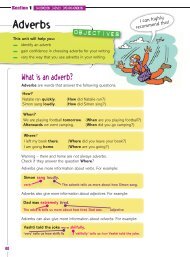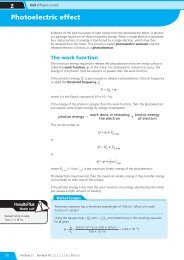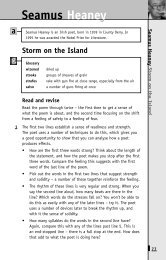Unit 2046 - Brickwork Level 2 CAA Diploma ... - Pearson Schools
Unit 2046 - Brickwork Level 2 CAA Diploma ... - Pearson Schools
Unit 2046 - Brickwork Level 2 CAA Diploma ... - Pearson Schools
Create successful ePaper yourself
Turn your PDF publications into a flip-book with our unique Google optimized e-Paper software.
<strong>Unit</strong> <strong>2046</strong><br />
How to carry out thin joint masonry and masonry cladding<br />
168<br />
<strong>Level</strong> 2 NVQ/SVQ <strong>Diploma</strong> <strong>Brickwork</strong> 3rd edition<br />
Remember Forms of construction where the thin joint<br />
system can be used<br />
The standard block size is<br />
440 mm x 215 mm<br />
Safety tip<br />
Always remember the basics<br />
of kinetic lifting techniques<br />
when handling blocks,<br />
particularly the larger size<br />
blocks available with the<br />
thin joint system<br />
Remember<br />
It is essential that the bed<br />
course is level and free from<br />
imperfections prior to laying<br />
the first bed of the thin joint<br />
mortar<br />
Remember<br />
You must always ensure that<br />
the course that is to receive<br />
a bed of thin joint mortar<br />
is free from dust as this can<br />
adversely affect the adhesion<br />
of the mortar<br />
Key term<br />
Superstructure – work<br />
above the DPC<br />
Figure 5.17 A bed course of<br />
blocks laid with traditional<br />
mortar bed and with thin joint<br />
mortar vertical joints<br />
The structure and composition of Aircrete blocks make them a<br />
very versatile material. When they are used in conjunction with<br />
the thin joint mortars that are now available, the thin joint system<br />
becomes suitable for most aspects of construction normally<br />
associated with the more traditional types of materials. The thin<br />
joint system can be used for any of the following:<br />
foundations<br />
partition walling<br />
external solid walling<br />
cavity walling<br />
separating or party walls.<br />
As the thin joint system has high resistance to both water<br />
penetration and frost, few problems are encountered when it is<br />
used for external solid walling. However, it is recommended that<br />
the external face of the blockwork is finished with either cladding<br />
or a traditional rendered finish, particularly where the wall is<br />
constantly exposed to inclement weather, such as rain and frost.<br />
The thin joint system also has a high resistance to fire and good<br />
sound insulation qualities, making it highly suitable for the<br />
construction of partition walling and separating walls.<br />
The strength and sulphate resistant properties of the system,<br />
also make it suitable for foundation walls in most types of soil and<br />
ground conditions.<br />
Methods of construction using the thin<br />
joint system<br />
If constructing a cavity wall structure, it is important to ensure<br />
that the substructure walls are built up to the damp proof course<br />
(DPC) prior to laying the inner thin joint blockwork. This enables<br />
any required openings to be set out accurately before work starts<br />
on the superstructure.<br />
2–3 2–3 mm mm thin joint thin mortar joint – mortar –<br />
vertical joints joints in order in to order to<br />
maintain bonding accuracy<br />
for maintain the next course bonding of blocks accuracy<br />
for the next course of blocks<br />
10 mm bed joint laid with<br />
traditional mortar to enable any<br />
inaccuracies 10 mm bed joint in the la concrete to be<br />
traditional mortar<br />
taken inaccuracies out and in to theproduce<br />
a level<br />
bed taken for the out and thin to joint p system<br />
bed for the thin jo


